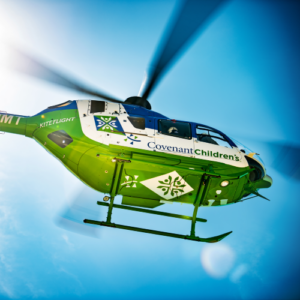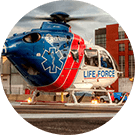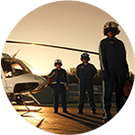When traveling across the country or around the globe, accidents and illnesses can happen. And if they do, most people will prefer to be close to friends, family and their own doctors to recover. When you are hospitalized the need to be near the familiar is even greater. Unfortunately, certain health conditions may prevent transportation home via commercial airline or air ambulance. Learn more about when a patient is too sick to fly.
Health requirements to fly
Generally, the cabin crew can bar a patient from flying if they feel their medical condition may be a safety concern for the patient or other passengers. Contagious illnesses, like influenza, COVID, or Chicken Pox may result in denied boarding. Passengers unable to remain seated due to illness or injury, or *those who cannot evacuate in an emergency, may also be too sick to fly.
Injured and too sick to fly
Many injuries can be accommodated on a commercial airline. People with broken limbs are usually able to fly on a commercial plane. However, those needing traction – or with back/neck injuries may not be able to sit, making flying difficult on a normal plane. In fact, some of these passengers may be unable to use commercial flights. When possible, the airplane crew might seat an injured person in business or first class to offer some more comfort measures. If the injury impacts normal bodily functions like breathing (i.e. a spinal cord fracture) a patient would not be able to fly commercially. Lastly, if the patient’s injury makes it harder for themselves or other passengers to deboard in an emergency, cabin crew may choose not to allow them to fly.
Ill and too sick to fly
Many illnesses make flying commercial airlines risky or impossible. Because most commercial jets fly so high, the cabin air is unsuitable for those with lung or heart issues. Patients with Chronic Obstructive Pulmonary Disease (COPD), for example, might not do well in the low oxygen, low pressure environment of a plane at cruising altitude.
These oxygen poor environments make people with heart conditions at risk as well. The heart has to work harder in a commercial aircraft and that can worsen underlying heart issues. Those who have recently had a stroke, heart attack, pulmonary embolism or other serious heart or lung issues may not be able to fly. Pregnant women in the third trimester are also discouraged from flying due to the possibility of going into labor.
Air Ambulances when you are too sick to fly
Getting home to continue care but being too sick to fly on a commercial flight can be possible with an air ambulance. Patients on board air ambulances usually travel on a bed, so concerns about positioning the patient on an aircraft are eliminated. For patients with heart or lung conditions, air ambulances offer onboard oxygen and adjustments to the internal cabin pressure, improving patient comfort and safety. Those patients who are hospitalized due to contagious illness can many times fly in an air ambulance- though this would be on a case-by-case basis.
Patients who are very ill and who require lifesaving medications and interventions can also be transported on air ambulances over long distances. Though the patient has to be stabilized prior to the flight, highly trained medical crews on air ambulances deliver ICU-level care during transit. They maintain constant communication with ground medical control to ensure the patient’s well-being.
It’s smart to plan for the worst-case scenario: getting seriously sick or injured far from home. When you purchase Fly-U-Home or Fly-U-Home International (which includes domestic transport), you’ll never pay out-of-pocket for your air medical care. If you are too sick to fly, for almost any reason, air ambulance crews can maintain a high level of medical care and get you closer to home to recover fast. There is no greater peace of mind than being prepared.
Learn about adding Fly-U-Home coverage today or read a patient story about being too sick to fly and how AMCN membership helped.
When a program provides bedside-to-bedside service, the transport medical team accepts the patient at the bedside in the originating facility and delivers the patient to the bed of the receiving facility.
Yes, although it’s not always possible. It will solely depend on available space on our aircraft. All aircraft have the ability to accommodate a passenger, however, this space could be lost due to additional medical staff or medical equipment.
Anyone that resides in the household.

Prepare for Travel with Expert Pre-travel Health Tips
Pre-travel health care is important for both domestic and international trips. It helps ensure you are ready to handle any common health problems that might

Neonatal Intensive Care – Be prepared for baby with this important information.
Having a child can be both exciting and a little scary. New parents want to be ready for their baby’s arrival and make sure they

Snowbirds and Expats Should Consider Air Medical Membership
Each year, millions of Americans spend the winter months in sunnier locales like Florida, Nevada and Arizona. Unfortunately, illness or injury during travel can lead




